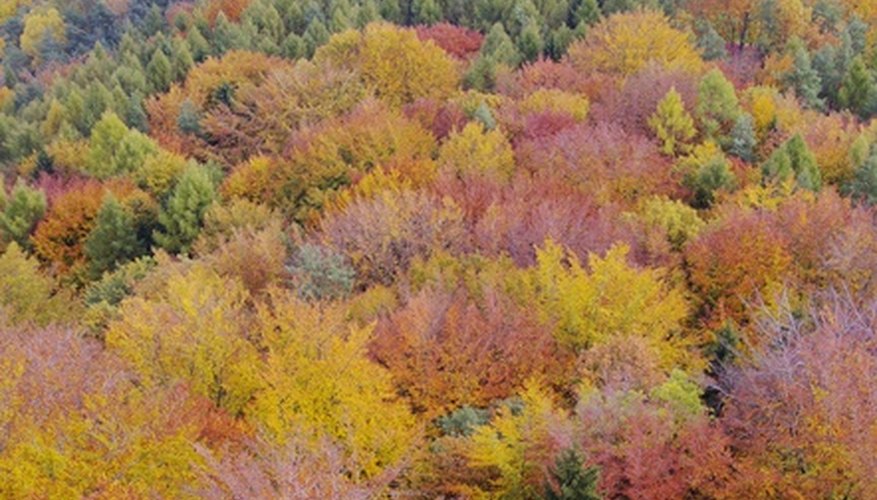A food chain shows the connections between living things in a particular habitat, such as the deciduous forest. On a food chain chart, a straight line leads from the most numerous, most-eaten organisms to the largest organisms with no natural predators. Food webs are more complex and multidirectional food chains that show which animals eat more than one type of organism.
Producers
Producers lie at the bottom of every food chain. In a deciduous forest, producers include ferns, berry bushes, fruit trees and fungi on rotting logs. The seeds, fruit, flowers and leaves from these producers sustain insects and small, herbivorous mammals. Since they support the rest of the deciduous forest biome, producers are the most numerous members of the food chain. On a linear food chain, plants like these are always the foundation. However, in a food web, large omnivores, like bears, also eat producers.
- Producers lie at the bottom of every food chain.
- However, in a food web, large omnivores, like bears, also eat producers.
Consumer Insects
Consumers branch out into several different categories, all of them herbivorous. The smallest are the insects. These scuttling creatures feed on leaves, twigs, fungus and moss. Some even eat rotting tree bark. Insects help break down organic matter, creating more fertiliser for the environment.
- Consumers branch out into several different categories, all of them herbivorous.
Warm-Blooded Consumers
Warm-blooded consumers include small rodents and birds. Mice, rats, squirrels, songbirds and cardinals feast almost solely on seeds and fruits. Some of these creatures, however, also add insects to their diet, making another sideways arrow on the deciduous forest food web.
- Warm-blooded consumers include small rodents and birds.
- Mice, rats, squirrels, songbirds and cardinals feast almost solely on seeds and fruits.
Last on the list of consumers are the large herbivorous mammals. Deer, moose and elk crop grass, strip bark from trees and consume the soft tips of tree branches.
Small Predators
The small predators of the deciduous forest are mid-sized mammals like raccoons, possums and skunks as wells as birds like blue jays, ravens and crows. Blue jays, possums and skunks feast mostly on insects, which feed on plants. However, these small predators may also eat seeds and berries, meaning they eat both consumers and producers. Foxes, hawks and owls eat birds and rodents, like finches, cardinals and mice. These birds and rodents eat insects, which eat producers. This is a case of predators eating other predators rather than predators eating only consumers.
- The small predators of the deciduous forest are mid-sized mammals like raccoons, possums and skunks as wells as birds like blue jays, ravens and crows.
- Foxes, hawks and owls eat birds and rodents, like finches, cardinals and mice.
Large Predators
Deciduous forest predators in the larger category include mountain lions, bears and wolves. These predators hunt large game like deer and elk, as well as smaller game like rabbits. Bears will also consume producers, or plants, like berries and bark as well as insects like grubs, making them omnivores. Large predators live only in small numbers in the deciduous forest, but they're so large and powerful that they sit on the top of the food chain or web.
- Deciduous forest predators in the larger category include mountain lions, bears and wolves.
- These predators hunt large game like deer and elk, as well as smaller game like rabbits.
